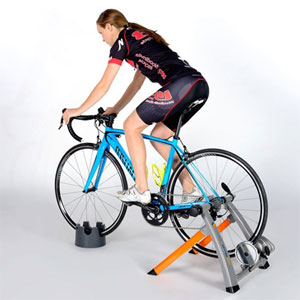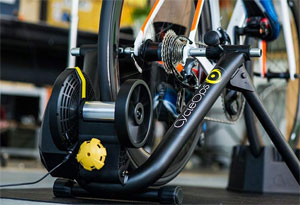
Many avid cyclists like to stay in shape during the winter season or when inclement weather ruins plans for long distance rides around town. Having a handy bike trainer in your home gym, garage, or living room is a great tool for the cyclist who doesn’t want to miss a day on the bike due to unsafe road conditions.
A good bike trainer is also an excellent training tool for helping riders build strength and stamina when trying to extend their route distance and performance. Seasoned cyclist and those who are brand-new to the sport, should consider a variety of options when prospecting the best bike trainer stand that will cater to their personal preferences.
There are three common types of trainers that assist riders in building their on-road agility. The common model design consists of the wind, magnetic, and fluid indoor bike trainers. Typically used and stored indoors, the median weight of this product is within 20-30 Ibs and is easily transportable. Whether you plan on using your trainer on stormy days, warming up before a race, or avoiding the lactic acid build up in your leg muscles post-race, if you plan on taking the sport of cycling seriously, then this is a must-have piece of equipment that will enhance your performance and endurance.
Bike trainers are easily adjustable and commonly fit bike tire sizes ranging from 26 to 29-inches as well as the common 700c bike wheels. You can find your tire size by the small number sticker insignia on the inner portion of your wheel rim, or in your bicycle model or user manual. Keep in mind that there are specially made bike trainer tires that are available in a variety of colors. These special tires are smooth and lack any tread to promote a gentle glide that benefits the longevity of your street tire, as well as your indoor bike trainer.
Below are the three most common bike trainers on today’s market. They vary in price and can cost anywhere between $60 to $2500. View and compare the styles to see which design will best benefit your bike trainer workout.
Key Takeaways
- Bike trainers are ideal for cyclists who want to stay in shape, improve their performance, or avoid bad weather conditions.
- There are three common types of bike trainers: wind, magnetic, and fluid. Each has its own advantages and disadvantages in terms of noise, resistance, and durability.
- Smart bike trainers are a newer option. They use Bluetooth technology to connect with apps and devices that can track and enhance your training.
- Bike trainer accessories such as trainer tires, mats, riser blocks, and sweat nets can improve your comfort, stability, and cleanliness when using a bike trainer.
- The best bike trainer for you depends on your personal preference, style, and budget.
Wind Bike Trainers
The wind trainer is the least common of the trainers, but is an affordable purchase and gets the job done. The wind trainer functions with a fan that increases resistance the harder and faster the cyclist pedals. The downfall that leads to the wind trainer’s unpopularity is the amount of fluttering noise produced by the fan and the limited number of options available for adjustable resistance.
Magnetic Bike Trainers
The Magnetic trainer utilizes a magnetic flywheel that provides effective resistance for the back tire. Different brands vary with some resistance levels, and the amount of noise produced when riding is minimal. Size fittings are easily adjustable, and many models are typically made with a durable stainless steel material. A wide base provides excellent stability, however, though resistance levels are limited, the Magnetic trainer has been known to break after applying a serious amount of resistance that the Magnetic flywheel cannot simply handle.
Fluid Bike Trainers
The Fluid bicycle trainer has gained a quality reputation as a top contender on the market because of its natural road-like feel of resistance. The Fluid trainer consists of a combination of an external flywheel along with an internal silicon liquid that increases resistance when the user increases pedaling speed. A popular model due to its unique design and smoothness and many brands utilize a durable and stable stainless steel frame. The Fluid is just as quiet as it sounds and is the ideal design for the home gym or living room. You can conduct business over the phone or watch your favorite morning news channel without any noise interference. However, the fluid models are prone to leakage after excessive long term use as they are capable of overheating and expanding.
Smart Bike Trainers
The Kinetic Smart trainer utilizes the Fluid resistance unit and is just as quiet when in motion. The difference, however, is that smart trainers use smart technology with Bluetooth sensor capabilities that are compatible with a variety of apps that can be easily installed on your smartphone, laptop, or tablet. Have the luxury of recording your time trials, performance statistics. Take your training to the next level and keep track of your progress via your Apple or Android smartphone and use bike trainer software to go on a virtual bike ride. Smart bike trainers are a great tool for the avid cyclist, but this technology, though new, isn’t cheap. Riders can look forward to paying around $350 to $500 for a smart trainer which is a fair price for the advanced systems of technology.
Bike Trainer Accessories
There are a variety of options that will assist in your comfort level and noise reduction when you jump on your bike and hit the trainer for a workout. These products vary in quality and can be found online or at your local bike shop. Most items are affordable and are designed to enhance performance.
As it was discussed earlier, an important accessory is the bike trainer tire. Riders can buy a quality trainer tire for under fifty dollars in most cases, and this is a great accessory to have for your trainer bike or the bike you utilize every day on the road. The trainer tire acts as a replacement so that your regular road tire doesn’t wear down, or give you problem with efficiency when you take to the roadways. Not to say that your rear bike tire won’t function after it has been on a bike trainer, however over long-term use, you could experience a decrease in grip and traction with your everyday tire. The trainer tire is smooth and is a solid replacement when utilizing your bike trainer and also reduces noice levels.
If you are experiencing excessive noise with your bike trainer, typically common with the wind trainer design, purchasing a bike trainer mat will help you out in the long run. The sole purpose of this accessory is to help muffle the vibration, sound, and also help with maintaining traction without sliding or losing position caused by intense indoor riding sessions. The trainer mats are lightweight, roll up into a compact cylinder, and make for easy transport and storage. They are commonly made of a synthetic rubber or plastic material. Great for riders who live in an apartment building which may be receiving noise complaints from their neighbors on the floor below. Trainer mats are relatively affordable and can cost anywhere between $15 to $70. A great accessory to have for those cyclists who are riding indoors.
To even out and level your indoor ride on your bike trainer, a front wheel riser block is another great tool to have to help support stability and posture. The riser block elevates the front tire of your bike, so it sits flush with the bike trainer. They come in a variety of different shapes and sizes and range from $15 to $25. Usually, the design consists of a variety of grooves designed to fit specific tire widths and also acts as an anchor that provides traction to the floor. Many bicycle trainers include front wheel risers in their packages, but if they do not, finding one at your local bike shop or online is simple.
No doubt about it that riders will work up a sweat when biking indoors. Bikers exert mass amounts of energy through their entire body and without the outdoors breeze to cool you down, or at least keep you somewhat dry, you will sweat profusely, and this loss of body water can drip across your bike frame, into your bike chain, and onto your floor. Having a bike sweat net attachment will prevent dripping perspiration from leaking onto the bike and chain which will also prevent possible chain rust. The sweat net stretches between your legs and across the center frame portion of the bike and secures to the bike seat post and latches to the handle bars. A great accessory for the rider who likes to keep their workout area, as well as their bicycle in clean shape.
Conclusion
Finding the best bike trainer is really up to your personal preference and individual style. There are plenty of routes to take when purchasing the bike trainer that fits you best and there are a plethora of accessories available on today’s market that will benefit your comfort, performance, and cleanliness. The most common cycling trainers are the ones that make the least amount of noise and have the highest amount of smoothness, particularly the magnetic and fluid trainers are the best run, or ride, for your money.
Buying the accessories with your bike trainer, if they don’t come included, will benefit your comfort level and quality of performance. A quality bike trainer and optional accessories can be found online or at your local bike store. Browse and compare the models online before you make a purchase to see which product best fits your needs and budget.

